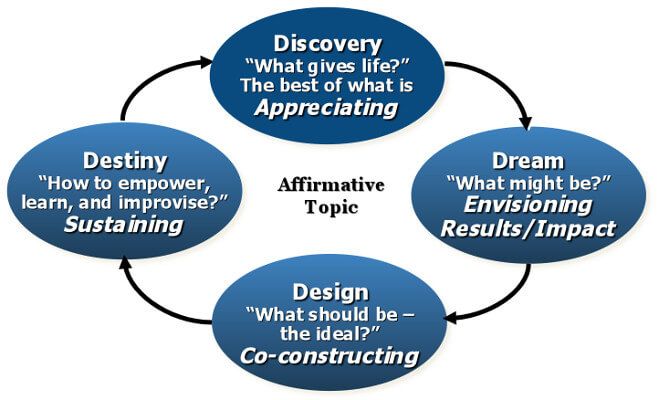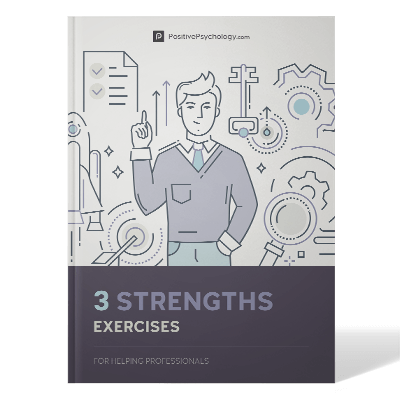

Appreciative Inquiry (AI) is a strengths-based approach to examining and developing the best in human systems.
The approach has a lot of overlap with positive psychology in its focus on what’s working, what’s good, and what gives us life.
By virtue of its flexible nature, AI can be applied to understand and change individuals, teams, businesses, or even societies. And it works by asking unconditional, positive questions.
In this article, we’ll see what Appreciative Inquiry Interview Questions look like and give you examples to help you create your own. I’ll introduce the 4D model as a systems paradigm, and consider the flexibility that makes Appreciative Inquiry so versatile.
Before you continue, we thought you might like to download our three Strengths Exercises for free. These detailed, science-based exercises will help your clients realize their unique potential and create a life that feels energizing and authentic.
To understand Appreciative Inquiry interview questions and to be able to create your own, some background into the Appreciative Inquiry Model is useful. But, put simply, AI is about understanding strengths and the positive core of a human system. AI interview questions are what we ask to discover these strengths.
At different stages of the Appreciative Inquiry Model, interview questions will reflect varying goals. What’s worth knowing at this stage is that AI was originally developed as a qualitative research method, so there are no closed questions in Appreciative Inquiry.
But rather than list all the things that AI Interview Questions are not, here is a short explainer that might give you an intuitive ‘feel’ for what they are:
Appreciative Inquiry began in the 1980s, while David Cooperrider and Frank Barrett were conducting action research into an organization. According to Bushe (2013), discussions of the feedback weren’t going too well, and the participants were reacting in a hostile way to their questions.
This led Suresh Srivastva, their supervisor at the time, to suggest something interesting: What if the questions themselves were influencing the negative dynamic?
Indeed, when the researchers adapted their questions to have a more positive focus, they found things changed considerably—it was much easier to make positive change and improve things there. So while AI interview questions were originally intended to refine qualitative research methods, they also became the basis for an entire paradigm.
A question is only as good as the answer it evokes, and questions thus contribute to success or failure across different contexts.
In practice, anyone can do AI interviewing, if they have the right motivation and mindset. You can ask yourself AI questions to find out more about your own strengths and create sustainable changes in yourself, or a coach can ask you questions.
In organizations, everybody involved in an initiative will usually be familiarized with AI, as Appreciative Inquiry is largely about co-creation. External stakeholders can be included, too—one of the goals of the approach is to gather diverse perspectives.
Let’s look at how the goals of each stage differ throughout the 4D model.
The 4D model is a visual representation of how Appreciative Inquiry plays out. There are 4 phases through which participants progress once they have selected an affirmative topic to focus on. However, defining the affirmative topic will often involve careful thought—as a facilitator, leader, or participant, the questions you ask during this process can also affect how ideas are framed (Ludema et al., 2006).
1: the act of exploration and discovery.
2. To ask questions; to be open to seeing new potentials and possibilities.
Synonyms: DISCOVERY, SEARCH, and SYSTEMATIC EXPLORATION, STUDY.”
(AI Commons, 2019)
Four different phases make up the 4D model, these are Discovery, Dream, Design, and Destiny. Once an affirmative topic has been defined, the participant or participants will move through these in sequence.
Below is an overview of the different phases; the aims of each will shape the nature of questions that are most relevant. Throughout, I’ll also be highlighting just how and why Appreciative Inquiry is so closely linked with positive psychology.
The Discovery phase is about appreciating the positive core. During this phase, participants ask questions that explore and identify strengths—of a team, organization, group, or individual. AI is concerned with using strengths to grow, change, adapt, and improve, so the more diverse a group, the more ground can be covered in the metaphorical search (Lewis et al., 2016).
We can also think of Discovery questions by recalling that Appreciative Inquiry is born out of grounded theory, and is inherently a qualitative method, so subjectivity is implied (Collis & Hussey, 2013). In essence, it calls for the mindset that there are no right or wrong answers—our organizational realities are made up of the stories we tell ourselves and each other.
The more people we include, and the more we explore and discuss, the more likely we are to reach a shared understanding of the positive core. In research methods lingo, we will hardly reach theoretical saturation, but we can aspire to it (Collis & Hussey, 2013).
As Cooperrider and Godwin put it (2011), the overarching question in this phase is: “What gives life?”
Picture a scenario where participants have come together, and we have been asking each other positive questions about things like our past achievements. A little further on, I’ll give specific Appreciative Inquiry interview questions, but for now, suffice to say we’ve been asking each other what made those successes possible.
Engaged and full of positive emotions (two elements of Seligman’s PERMA model, by the way), the next phase we move into is Dream. Our collective focus here is envisioning possibilities, thinking, and imagining (Cooperrider & Godwin, 2011; Whitney et al., 2004). In one sense, it’s practical and still focused on the past. In another, it expands on this with the aim of generating more from this.
Here, the goal is to envision what we want to happen—in contrast to some conventional practices like real options analysis, which can sometimes focus on ‘what if’ in a different way (Johnson et al., 2017). Rather, we ask questions about stories; then, we can ask questions of those stories to elicit more in the way of rich detail around themes. These may include dream dialogues, which look at building out aspirations and wishes about the shared future.
The overarching question of the Dream stage, is therefore:
The Design stage is about building the visions and ideas with the greatest potential, together. In co-constructing ‘the ideal’, therefore, the questions become slightly more specific and focused on clarifying. To get from a dream of “super-enthusiastic customer service” to the concrete strategic focus, for instance, participants now ask positive, provocative questions.
These are aptly called ‘provocative propositions’, and they aim to create compelling, clear images of social architecture that could make the dreams possible (Whitney et al., 2002; Ludema et al., 2006). Provocative propositions use the present tense, so interview and probing questions should reflect this.
Encouraging provocative propositions and sharing requires a supportive environment that encourages and invites openness (Axtell et al., 2011; Ludema et al., 2006). In this sense, it calls for sensitivity to team relationships and healthy collaborative dynamics to get the best possible outcomes.
The overarching question of this phase is:
We now ideally have images of a shared, positive future that leverages our organizational strengths. The Destiny stage is about encouraging shared commitment and discussing how teams and individuals will help bring provocative propositions to life. This can be seen as distinct from traditional approaches in its focus on collective meaningfulness and purpose.
The overarching question here, according to Cooperrider and Godwin (2011), is:
“How to empower, learn, and improvise?”

Source: Source: Cooperrider & Godwin (2011)
In a nutshell, the questions we ask at each stage will reflect the relevant goal of that stage. But asking the overarching questions as outlined are only going to get us so far. In a qualitative study, for example, it would be somewhat akin to asking your research question of participants directly—deliciously tempting, but not the best way to elicit rich, informative answers.
There are several principles that can help you design AI interview questions, and these will build on, rather than simply read out, the overarching questions at each stage. Whitney et al. (2002) describe these as ‘The Anatomy of a Positive Question’ in their book: Encyclopedia of Positive Questions. Let’s see what they say.
Succinctly put, an appreciative or positive question is:
“A question that seeks to uncover and bring out the best in a person, a situation or an organization.”
(Whitney et al., 2002: 89)
They are relevant to the affirmative topic chosen, and made up of:
Crafting questions and understanding what you (all) want from the experience is a brilliant start, but here are some more tips to help (Whitney et al., 2002):
Michelle McQuaid, a co-author of several studies with Professor Cooperrider, has also shared tips from her interview with Jon Berghoff. Berghoff is co-founder of the Flourishing Institute, and he suggests three helpful categories of everyday questions at work (McQuaid, 2019).
These are about meaning at work and they look into the deeper ‘why’ of what we do. So, beyond external incentives like KPIs and monetary rewards, we ask questions to understand our collective purpose—sometimes above and beyond the organization’s official vision.
For example: “Why does our work on this particular project really matter to us?” “What is it that we’re doing here and now that makes us really proud?”
Strengths questions go right back to ‘the whole point’ of AI; they’re about what is good and what works best. To look for what’s making something work, we might first ask about best practice for instance—if there’s not a lot at all that is working inside the organization, look outside at other companies.
For instance, “What does XYZ company in our sector do exceptionally well?” “What makes us best in class at new product development (NPD)?” Or “What’s making our team the best it can possibly be?”
Then ask what’s behind that good performance, success, or development.
For example: “What does XYZ do that we can learn from?” Or, if it’s teamwork that’s making NPD so spectacular, “How can we build even more on the way we collaborate?”
These are Appreciative Inquiry visioning questions, designed to inspire positive images of the future for a team, division, or organization. Future vision questions aim to guide positive action through creative imagining of possibilities and the hope that we can achieve these through our strengths (Cooperrider, 1990).
Examples include: “What does your ideal future look like for the team?” and “What would be your best aspirations for our organization in five years?”
Hopefully now, it’s easy to see why AI interview questions can easily be adapted to suit different contexts; one of these is coaching.

These detailed, science-based exercises will equip you or your clients with tools to discover and harness their unique strengths.